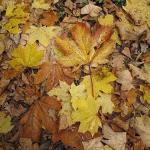 September is generally a cooler, gustier month than August and the days are noticeably shorter. While there’s not as much to do in the ornamental garden at this time of the year, if you have a fruit or vegetable patch, you’ll be busy reaping the rewards of harvest.
September is generally a cooler, gustier month than August and the days are noticeably shorter. While there’s not as much to do in the ornamental garden at this time of the year, if you have a fruit or vegetable patch, you’ll be busy reaping the rewards of harvest.
At this time of year it is really important for every gardener to get their compost going by buying a compost bin or building a partially enclosed and easily accessible area for a heap. It is essential to replace the goodness in soil and autumn produces quantities of garden waste that will add invaluable organic richness back into your soil next spring.
 Remember to add a variety of different material. Good things to compost include vegetable peelings, fruit waste, teabags, plant prunings and grass cuttings. These are fast to break down and provide important nitrogen as well as moisture. It’s also good to include things such as cardboard egg boxes, scrunched up paper and fallen leaves. These are slower to rot but provide vital fibre and carbon and also allow important air pockets to form in the mixture. Crushed eggshells can also be included to add useful minerals. Having a smaller compost bin in the kitchen is a great way to recycle the food waste from cooking without having to go out to the garden every time.
Remember to add a variety of different material. Good things to compost include vegetable peelings, fruit waste, teabags, plant prunings and grass cuttings. These are fast to break down and provide important nitrogen as well as moisture. It’s also good to include things such as cardboard egg boxes, scrunched up paper and fallen leaves. These are slower to rot but provide vital fibre and carbon and also allow important air pockets to form in the mixture. Crushed eggshells can also be included to add useful minerals. Having a smaller compost bin in the kitchen is a great way to recycle the food waste from cooking without having to go out to the garden every time.
Certain things should never be placed in your bin. No meat or dairy products unless you’ve opted for a digester. No diseased plants, and definitely no dog or cat litter, or babies’ nappies. Putting any of these in your compost will lead to unwanted pests and smells. Also avoid composting perennial weeds (such as dandelions and thistle) or weeds with seed heads. Remember that plastics, glass and metals are not suitable for composting and should be recycled separately.
 The key to good compost lies in getting the mix right. You need to keep your ‘greens’ and ‘browns’ properly balanced. If your compost is too wet, add more ‘browns’. If it’s too dry, add some ‘greens’. Making sure there is enough air in the mixture is also important. Adding scrunched up bits of cardboard is a simple way to create air pockets that will help keep your compost healthy. Air can also be added by mixing the waste and cuttings, which leads to faster composting.
The key to good compost lies in getting the mix right. You need to keep your ‘greens’ and ‘browns’ properly balanced. If your compost is too wet, add more ‘browns’. If it’s too dry, add some ‘greens’. Making sure there is enough air in the mixture is also important. Adding scrunched up bits of cardboard is a simple way to create air pockets that will help keep your compost healthy. Air can also be added by mixing the waste and cuttings, which leads to faster composting.
When your compost is ready you’ll have a dark brown, almost black soil-like layer at the bottom of your bin. It should have a spongy texture and will be rich in nutrients. Spreading the finished compost into your flowerbeds greatly improves soil quality by helping it retain moisture and suppressing weeds. It also reduces the need to use chemical fertilisers and pesticides.
We really believe that composting is the easiest way to make your garden grow more beautiful.
[gravityform id=”1″ name=”Contact”]

